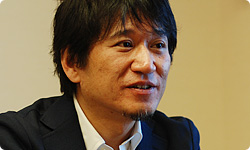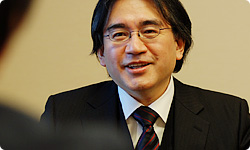4. Speeding and Exhilaration
It seems like a new Ridge Racer game always comes out with the release of a new piece of hardware. It’s become a tradition. What does NAMCO pay particular attention to each time?
It’s a simple word, but we aim for speed. And the exhilaration that comes from that speed is where it all begins.
You want players to experience the exhilaration that comes from hurtling along at breakneck speeds. What themes did you work with this time in making a game for the Nintendo 3DS system?
It’s 3D, so we wanted to make the best use of that—for example, in scenes where the car in front of you gets hit, loses control, and flips back and bangs into the front of your car. We thought something flashy like that would be cool in 3D, and at first it actually was cool when we put in scenes like that.
Ah. But only at first.
Yes. When you’re pleasantly cruising along and something like that happens, it doesn’t feel very good. But when development began, everyone around us was saying, “It’s 3D, so make it flashier!” They wanted the cars to slam into each other.
Like they were flying off the screen? (laughs)
Yeah. (laughs) I can understand why you might want to do that, but when a car cuts across you all of a sudden, it breaks your rhythm. We’ve always wanted players of a Ridge Racer game to get into a rhythm and enjoy that feeling of speeding along.
When you’re driving well in a racing game, you often get into an egoless state and rise above yourself.
Right!
Put another way, sports athletes talk about entering a zone.
Yes, that’s it!
When you get in that state, things like impact and flashy presentation becomes just a hindrance.
Right! As mentioned earlier, we could really portray the substantiality of the cars this time with a 3D effect, so we played off that and tried through our development of the game to induce the feeling of exhilaration that comes from speed.

I heard that you tried other new features as well with the Nintendo 3DS system.
Yes. One stems from StreetPass.16 When you pass by someone you don’t even know, you pass your ghost data to them. 16StreetPass: A feature that allows users who enable it to walk around with their Nintendo 3DS system turned on to exchange game data with other Nintendo 3DS users that they pass on the street.
You send it to them?
Yes. You can send it to them, and sometimes you receive ghost data from them. And you can race against that ghost data in StreetPass Duel.
When you pass by someone, you may exchange data, and then you can race each other’s ghost data anytime, anywhere.
Right. And when we went to put in the StreetPass feature this time, I remembered something. I was watching two boys play a racing game at a video arcade once, and what was interesting was how one would play and leave behind his ghost data. Then the other one would sit down and race that ghost data.
Usually, you would just play together.
Right. But those two would play in turns and watch each other’s driving.
You mean they would watch how the other one played and adjust their own driving accordingly?
Right. Like, “So that’s how you handle this corner...”
When you race simultaneously, you get caught up in your own driving and can’t observe what your friend is doing, so I think that’s why they were playing it that way.
When you take turns like that, you improve more quickly, so I think that is one way of playing. I think players will have fun with Ridge Racer 3D if they compare their best times.
What happened at video arcades before is now possible on the streets. (laughs)
Right. And your opponent is a ghost, so you can race it whenever you want and at your own convenience.
Something I’m really looking forward to when it comes to StreetPass is how you will be able to do things like compete everyday against people whose faces you don’t know but with whom you happen to commute in the same train with every day. That’s sort of exciting. (laughs)

Yeah, it is! (laughs) Until now, it was a bit of a pain when you wanted to exchange game data with your friends, but with the Nintendo 3DS system, all you have to do is stick it in your bag and you can exchange ghost data.
I suppose you’ll even pass people at work and be like, “Hey, that guy had his Nintendo 3DS system!” (laughs)
When you connected with a friend to race before, you had to arrange it beforehand, but this time you can do it at your own convenience, which I think is good. And the races end in three to five minutes, so it isn’t demanding. What’s more, you can store data for up to 50 ghosts from StreetPass.
You can choose to race people whose times are similar to yours.
Yeah. It’s depressing if you race people who are much faster. (laughs) I wanted players to race each other a lot, so you accumulate points the more you use StreetPass. Then, when you store up points, it’s easier to get new cars and items.
How is the content volume this time?
The game may be for a handheld system, but we increased the volume. For example, there are quite a few more courses. We made several new courses and there’s quite a rich selection of cars. There’s also a Grand Prix Mode with various race locations. More than 150!
Did you say 150?!
I did! So there’s plenty of racing to be done! There’s a variety of modes, too. For example, there’s the Tour Mode. Unlike the Grand Prix Mode, it allows you to select certain conditions—like you want to play for x number of minutes—and it automatically selects a course for you.
Like, “I’ve got five minutes for a quick race.”
Right. There are a number of conditions for selecting a course. You can choose courses for their emphasis on speed or curves. And then there’s the music. We often hear that the music in Ridge Racer is good, so the staff originally in charge of the music in the series made 15 new music tracks. Including some old music, there are more than 40 tracks!
That’s quite a lot!
Yeah. It’s quite a solid game in terms of content.